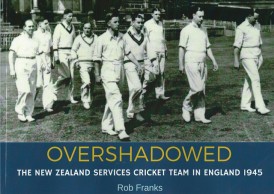Overshadowed
Martin Chandler |Published: 2017
Pages: 117
Author: Franks, Rob
Publisher: Rob Franks
Rating: 3.5 stars

Although the Ashes were not at stake, and the matches aren’t and never have been classified as official Tests, the series of five matches dubbed ‘The Victory Tests’ between an Australian Services Eleven and an England Eleven that were played in the summer of 1945 are pretty well known. Large crowds were attracted to matches that marked the resumption of ‘big’ cricket after five long summers of war. Public interest in the games, played in a celebratory manner by sides led by Lindsay Hassett and Walter Hammond, was high.
One of the first books I reviewed for CricketWeb was Mark Rowe’s splendid account of that series, The Victory Tests, so I thought I knew a good deal about that first peacetime summer. How wrong I was. I have to put my hand up and admit that if I had ever heard of a New Zealand Services Eleven who also travelled around England that summer I have long since forgotten about it. That there was such a tour is confirmed to me by this meticulously researched account by New Zealander Rob Franks.
Inevitably the New Zealanders were nothing like so strong as their Australian counterparts, but there were some fine players available nonetheless. Foremost amongst them were two top class batsmen, Martin Donnelly and Stewie Dempster, both of whom were well known in England. The side was led by Ken James, a wicketkeeper who played in all of his country’s first eleven Tests and who then qualified for Northamptonshire for whom he had played between 1935 and 1939. Other successful veterans of New Zealand’s early Test sides were all-rounders Roger Blunt and Ted Badcock. In the manner of the times there was a hard core of players who played in many of the matches, and others who floated in and out of the party as their duties permitted.
Franks suggests several reasons why the New Zealanders are now forgotten. Playing second fiddle to Hassett and Co is the main one. In addition the New Zealanders’ schedule contained just a single First Class match, so their profile was lower for that reason alone. The entirely valid point is also made that newsprint was in short supply, so in an era when the printed word was almost solely responsible for communicating news of the cricket there were more important things to report.
Of course if the matches were barely reported in England there was even less in the New Zealand press and Franks had a very difficult task to piece together the cricketing events of the tour. Inevitably the personalities were easier to deal with, all having continued their lives and cricketing careers after returning home and going on to see out their days in New Zealand.
Seventy years is a long time, and with limited newspaper space devoted to the tour it might have been expected that Franks would have found primary sources thin on the ground. In fact he didn’t. In New Zealand cricketing longevity seems to be encountered more frequently than elsewhere, and the biggest boost for Franks doubtless came from the fact he was able to speak to centenarian Tom Pritchard. The only disappointment would be that Pritchard figured only briefly on the tour. His name is not a well known one but he would almost certainly have been a fast bowler of international renown had he chosen to play for New Zealand on their 1949 tour of England, rather than throw in his lot with Warwickshire.
There were a clutch of nonagenarians available to Franks as well. Aged 95 Bob Metcalf had figured in wartime matches New Zealand Services sides played prior to 1945, and he contributed some interesting memorabilia. Likewise Derek Hamilton, a mere whippersnapper in comparison at 93, also played in earlier matches. No doubt most important was Alan Burgess, now 96, who played throughout the 1945 tour.
The book begins with an excellent introduction followed by a chapter putting the 1945 side in the context of its predecessors. After that there is an account of the tour. Some scorecards are reproduced but not all. Similarly some accounts of the play are more thorough than others, but represent a remarkable achievement none the less. Franks must have gone about his research with great patience and diligence as well as enthusiasm.
Perhaps inevitably the most interesting part of the book are the glimpses at the lives of the participants, and Franks deals with that particularly well. In addition to some quality writing the book is also well illustrated, and contains the statistics you would expect to see in this sort of account. The one irritation, to this reviewer anyway, is that the book is in landscape format. This means it is something that really needs to be read sat at a desk, rather than whilst lounging in an armchair. It also makes finding a place for it amongst my many other books somewhat tricky, although perhaps that is a cunning plan to make sure Overshadowed takes pride of place in its owner’s library?






Leave a comment